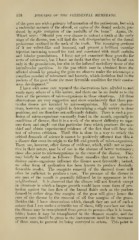Page 968 - My FlipBook
P. 968
978 DISEASES OF THE PERIDENTAL MEMBRANE.
of the gum nor with a primary inflammation of the periosteum, but with
a molecular necrosis of the alveoli, or caries of the dental sockets, pro-
duced by septic irritation of the medulla of the bone." Again, Dr.
Witzel says : " Should you ever chance to extract a tooth at the early
stage of the disease, you will find the soft disorganization of the dental
periosteum confined to the neck of the tooth. The remaining portions
of it are velvet-like and loosened, and present a brilliant vascular
injection increasing toward the root and associated with small nodules
and lobular granulations. I have not yet examined these growths for
nests of micrococci, but I have no doubt that they are to be found not
only in the granulations, but also in the infected medullary tissue of the
interalveolar partition. In the pus which may be obtained from the
aifected alveoli by pressing the gum we observe under the microscope a
countless number of micrococci and bacteria, which doubtless find in the
pockets of the gum tissue the most favorable condition for their contin-
uous develo}>ment."
I have with some care repeated the observations here alluded to and
made many others of a like nature, and there can be no doubt as to the
facts of the presence of micro-organisms in these situations. All these
observations are very suggestive and show conclusively that these par-
ticular tissues are invaded by micro-organisms. My own observa-
tions, however, are not explicit in determining a single variety in these
positions, and are therefore not sufficiently definite. There is such a pro-
fusion of micro-organisms constantly found in the mouth, especially in
conditions of disease, that it is a work of the utmost difficulty to sepa-
rate them and single out that particular form which produces the mis-
chief and obtain experimental evidence of the fact that will bear the
test of adverse criticism. Until this is done in a way to satisfy the
critical demands of science it cannot be positively affirmed that this is
a disease that owes its origin to the life and growth of micro-organisms.
There are, however, other forms of evidence, which, while not so posi-
tive in their nature, may be of use in the absence of better testimony;
these also point to micro-organisms as the cause of the disease. They
may briefly be stated as follows : Those remedies that are known to
destroy micro-organisms influence the disease most favorably ; indeed,
no other form of medication has been known to produce decidedly
favorable results. The complete removal of the diseased tissue will
often be sufficient to produce a cure. The presence of the disease in
one part of the mouth is generally followed by its appearance in the
neighborhood. It is observed that the disease will not flourish except
in situations in Avhich a fungus-growth would have some form of ])ro-
tection against the free flow of the buccal fluids such as the pockets
formed by rather deeji free margins of the gum will give ; hence the
cure of the disease l)y the removal of all free margins of the gums.
Besides this, I have observations which, though they are not of such a
nature that I can make a scientific use of them, fully convince me that
the disease may be transplanted from person to person—that it is inocu-
lable ; hence it may be transplanted to the cleanest mouths, and the
greatest care should be given to the instruments used in the treatment
of these cases, to prevent its being conveyed to others. This point is


